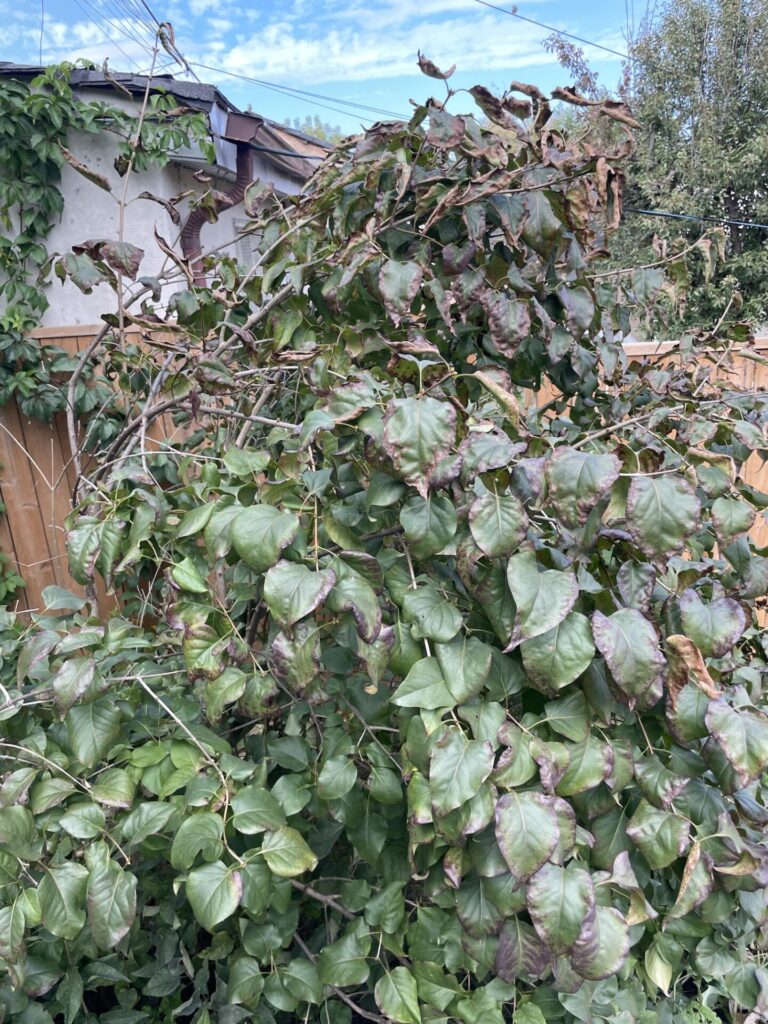
Hi there,
My lilac tree is not looking very well. Many leaves are turning purple – starting from the edges – and curling and drooping. The problem is worse at the top of the tree. Any ideas on what I can do to diagnose the issue and work towards improving it? I’m not very experienced with gardening and such but would love to learn. Thank you in advance. Here are more details and the image which shows the top portion of the tree:
– Size: about 6.5 ft tall, 3ft wide
– Location: Rogers and Dufferin, Toronto
– Soil: I think it’s loam? There is some black cedar mulch around the general area to discourage weeds
– Sun: The tree is exposed to sun on the East, and South to a lesser extent. Adjacent, on its west side, is a tall fence and giant manitoba maple which casts shade on it in the afternoon. I think it would be getting about 5 hours of full sun in the summer.
– Changes to Sun: We pruned the top of the Manitoba Maple tree during early summer, cutting back some of its height to get more sun in the garden (and on the lilac). Anyhow
– Watering: I would water the tree substantially about once a week in the summer
– Drainage – I am not sure how to know if the drainage is good but could investigate further
– Fertilizer: I’ve never applied any
– Nearby plants: around the lilac are lots of common burdock. I was pulling these out at the beginning of summer but it got away from me
– Pruning: I pruned away dead branches in the spring. There are lots of suckers sprouting form the ground so I pruned those as best I could at that time. I didn’t prune branches or remove suckers after that.
– Flowering: The tree flowered normally this season, but it was looking pretty good at that time.
Thanks in advance
Thank-you for contacting Toronto Master Gardeners with your question. Common Lilacs (Syringa vulgaris) are generally trouble-free, vigorous shrubs that can outlive home-owners. It is discouraging to see a once-healthy plant experience symptoms such as yours.
You have done a great job of describing the situation your shrub inhabits. Based on this, my first thought is that your lilac is suffering from the general lack of water this year, exacerbated by the increased level of sunlight due to the pruning of the Manitoba maple. Even your weekly watering may not have been sufficient. Many trees and shrubs in Toronto are suffering from the lack of significant rainfall through the summer and early fall, and their leaves are browning, and often falling earlier than usual. It is not unusual for lilac leaves to turn a purplish colour around this time, though the browning and drooping shown in the photo indicate more of an issue.
It is possible that your shrub is showing symptoms of disease. This article on How to Identify and Treat 7 Common Lilac Diseases gives very useful information that will help you to determine whether your lilac has contracted one of these diseases. It is difficult to diagnose these problems from the photo and your description. Many of the symptoms involve discoloured and curled leaves. Your shrub could have one of a couple of types of lilac blight, or possibly a witches’ broom. You can review the symptoms listed in the article and check on your plant. Lilacs are also prone to powdery mildew. A shady situation and high humidity can increase the likelihood of this disease. I cannot see any tell-tale white blotching on your leaves so this is less likely to be the problem.
Remedies for these diseases, and even for the more likely environmental stress, invariably involve pruning away the dead or distorted leaves and stems. These should be pruned to below the affected foliage. Your shrub looks like it has quite congested growth in that top portion. Pruning out the top portion and trimming some of the interior branches throughout the plant will help with light penetration and airflow. These actions should help promote plant health regardless of the underlying problem. Normally lilacs are pruned immediately after flowering so that the buds for next spring can form during the summer. In the case of dead or unhealthy branches, however, it is best to prune right away so that they do not cause or spread any fungal diseases. Be sure to bag the prunings for garbage disposal rather than compost so that there is less chance of spreading any possible disease.
The increased sunlight caused by the trimming of the Manitoba maple should be a good thing for your shrub in the long term. Lilacs love full sun. The only other suggestion is to ensure that the mulch around the shrub is not touching the trunk itself. This can cause disease problems. As well, clearing away the burdock will benefit your lilac. Continue to remove suckers each year, as you have been.
I hope these actions can help the lilac to regain vigour so that it survives the winter and flourishes next year.
October 7,2023

